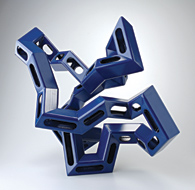| OUTREACH AND EDUCATION
RCSB PDB Celebrates Teaching, Learning,
and More

The RCSB PDB exhibits at meetings to get feedback from our users about
the resource. Recent education
and outreach activities have included:
- Annotators made models of virus structures with
local middle school students as part of Princeton University's
Science and Engineering Expo on March 19. The models included
marshmallow and toothpick representations of the viral shell and
paper models of the dengue fever virus.
- An exhibit booth was also held at the Teaching
& Learning Celebration in New York, NY, March 7-8. Educators and
policy makers from the Tri-State area came to the booth to learn
about protein structures, the RCSB PDB, and to take home tRNA
tattoos.
- The RCSB PDB exhibited at the Biophysical Society's
annual meeting (February 2-6; Long Beach, CA).
Protein
Sculptures on Display at Rutgers

Cycloviolacin (2007, copper-coated steel, 24" x 32" x 36")
Sculptures and photographs by Julian Voss-Andreae
were on display at the Rutgers Student Center in New Brunswick,
New Jersey in February.
Voss-Andreae's unique sculptures are designed to tell stories about
hemoglobin, collagen, and other structures essential to life.
Julian Voss-Andreae is a German-born sculptor based in Portland.
He graduated from the Pacific Northwest College of Art (PNCA) in
2004 with a BFA in sculpture. While still at PNCA, Voss-Andreae
developed a novel kind of sculpture based on the structure of proteins,
the building blocks of life. Voss-Andreae's work has been commissioned
internationally and has been highlighted in journals such as Leonardo
and Science.
Photographs of Voss-Andreae's sculptures are part of the RCSB PDB's
Art of Science traveling exhibit, which also features images available
from the RCSB PDB website and the Molecule of the Month. For more
information on hosting this exhibit, please contact info@rcsb.org.
The next stop for the cycloviolacin sculpture is the Art and Mathematics:
The Wonders of Numbers exhibit at The Heckscher Museum of Art, April
12 - June 22, 2008, in Huntington, NY.
Julian Voss-Andreae: www.julianvossandreae.com
The Heckscher Museum: www.heckscher.org
Papers
Published
The PDB archive, which began in 1971 as a handwritten petition
signed by crystallographers, has developed into an online biological
database and resource used by a diverse community of teachers, students,
and researchers in academia and industry worldwide. This history
is described in an article published in an issue of Acta Crystallographica
that commemorates various milestones in the crystallographic community:
Helen M. Berman (2008) The
Protein Data Bank: a historical perspective Acta Cryst.
A64: 88-95. doi: 10.1107/S0108767307035623
A paper describing the work done as part of the wwPDB Remediation
Project, including the standardization of IUPAC nomenclature for
chemical components, an update of sequence database references and
taxonomies, and improvements in the representations of viruses,
has been published in Nucleic Acids Research's 2008 Database
Issue.
K. Henrick, Z. Feng, W. F. Bluhm, D. Dimitropoulos, J. F. Doreleijers,
S. Dutta, J. L. Flippen-Anderson, J. Ionides, C. Kamada, E. Krissinel,
C. L. Lawson, J. L. Markley, H. Nakamura, R. Newman, Y. Shimizu,
J. Swaminathan, S. Velankar, J. Ory, E. L. Ulrich, W. Vranken, J.
Westbrook, R. Yamashita, H. Yang, J. Young, M. Yousufuddin, H. M.
Berman (2008)
Remediation of the Protein Data Bank archive Nucleic Acids
Research 36: D426-D433. doi: 10.1093/nar/gkm937
The data from the Remediation Project are available through the
FTP archive and wwPDB member sites. Detailed documentation about
the Remediation Project is available at www.wwpdb.org. |


